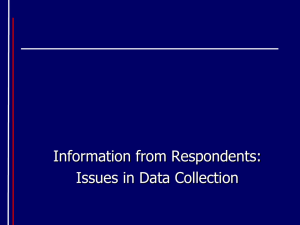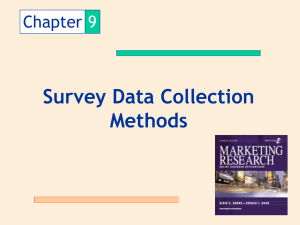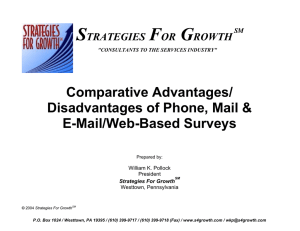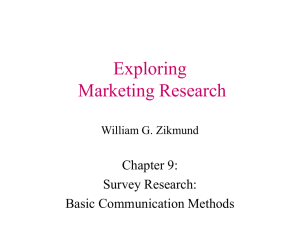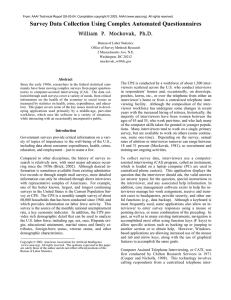Week 5
advertisement
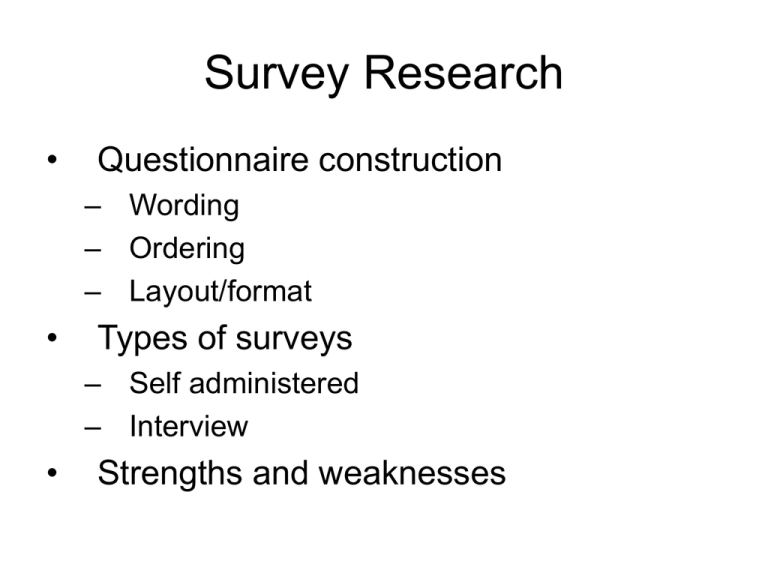
Survey Research • Questionnaire construction – Wording – Ordering – Layout/format • Types of surveys – Self administered – Interview • Strengths and weaknesses Question Wording • • • • • • • Ask questions R’s can answer Make questions clear and unambiguous Make questions relevant to topic Avoid negative items Avoid biased items, leading questions Avoid double-barreled questions Short items usually better Question Ordering •Goal: To get R to answer the questions • Self-Administered – Begin with interesting, non-threatening items – Less interesting middle to end – Most personal information at the end • Interview – Begin with least threatening items – Most personal items in the middle – Finish with less sensitive items Format/ Layout • • • • Neat, uncluttered Easy for R to follow One question per line Answers marked in boxes or circles: ( ) [ ] Contingency Questions • Apply to only some of the respondents • Set off with boxes and arrows or use instructions to skip questions: Do you have children under 18 at home? No If yes: please list ages_____________ Yes _______________________________ Alternative format for contingency questions 4. Do you have children under 18 at home? No Yes please skip to question 15 please go on to question 5 5. How old is your youngest child? 6. What child care arrangements do you use while at work? (Check all that apply)….. 7……… Matrix Questions • Set of questions with identical answer choices • Example: Strongly agree Agree Don’t know Disagree Strongly Disagree Husbands and wives should be equally responsible for financial support of their families. 5 4 3 2 1 A woman should take care of her family first, then her career. 5 4 3 2 1 Preschool children may be harmed if their mothers work. 5 4 3 2 1 A father can care for young children just as well as a mother can. 5 4 3 2 1 Using matrix questions • Easy to follow • Efficient use of space • May foster “response set” – solution is to alternate points of view occasionally • Answer choices should be appropriate for all items Self-Administered Questionnaire • • • • Mail, e-mail, web page, or handed out May not produce high response rate May be good for sensitive topics Less costly than interviews Insuring quality • • • • • Use probability sample Precede with cover letter. Include letter of explanation Monitor returns, use follow-ups if needed Always pay return postage! Follow-ups on mail surveys • Maintain confidentiality – use ID numbers • Keep list of returns • After reasonable time, send another questionnaire • May follow up with phone call • Improves response rate • May allow conclusions about nonrespondents Interviews • • • • • Questions read by researcher Answers recorded by researcher May be face-to-face or telephone Higher response rate than mail surveys More accurate responses – interviewer may ask for clarification • Better for more complex topics • Interviewer can observe and record without asking directly (but is it ethical?) Two main rules for interviewers • Get R’s confidence: Good listener, nonjudgmental, non-intimidating, appear interested in R’s opinions, dress appropriately, may be same gender as R • Don’t affect the results: Don’t volunteer own opinion, don’t appear as authority or expert, don’t judge R. Interviewer preparation • Know purpose of study, sponsor, researcher • Know how much to reveal to R • Questionnaire must include interviewer instructions • Follow wording and instructions exactly. • Record responses exactly. • Use probes only as instructed. • Interviewers should be supervised. Example of interviewer instructions: • http://www.macalester.edu/~dolan/POLI30/ interviewerinstructions.html Telephone Interviews • Use for short, uncomplicated topics • Saves money and time • May precede with cover letter – avoid being seen as “nuisance call” • Raises sampling issues – cell phones, unlisted numbers, people without phones Computer Assisted Survey Research: • Computer Assisted Telephone Interviewing (CATI) – Like regular telephone interview, but interviewer types respondent’s answers directly into computer • Computer Assisted Personal Interviewing (CAPI) – Like CATI, except used in face-to-face interview • Computer Assisted Self Interviewing (CASI) – Research worker brings a computer to the respondent’s home – Respondent answers on the computer • Computerized Self-Administered Questionnaire (CSAQ) – The respondent receives electronic copy of the questionnaire – Respondent returns the data file Also: TDE (touch-tone data entry), VR (voice recognition) Advantages and Disadvantages of Surveys Advantages • Good for describing large populations; statistical inference • Can handle large data sets and samples • Standardization = easy analysis • Can have multiple indicators of concepts • Relatively inexpensive Disadvantages • Can be overstandardized; categories may be artificial • May create opinion
